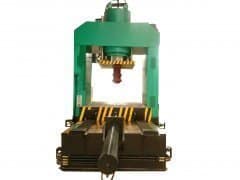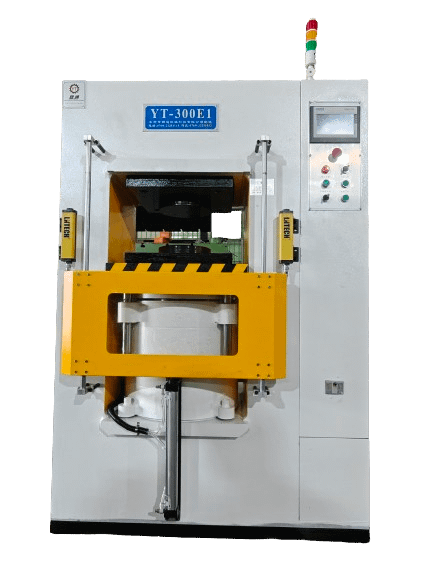How Much Pressure Can a Hydraulic Press Produce?
time:2023-08-30 views:(点击 980 次)Hydraulic presses use Pascal's principle to generate enormous forces. Consisting of two cylinders - a smaller slave cylinder and larger master cylinder - the slave pushes on a Plunger while master presses down on Ram.
The system is powered by a hydraulic pump which pumps oil at high pressure into cylinders to generate tremendous crushing force for metal objects.
Hydraulic pressure
A hydraulic press uses hydraulic fluid to generate and transfer force between pistons, making this machine suitable for various industries including metalworking, plastics and composites manufacturing, construction and automotive. A hydraulic press can produce immense force when compressing materials such as concrete into different shapes and sizes - however before beginning its use it's essential that users understand its workings as well as safe operating practices.
There is an impressive array of hydraulic presses on the market. Some may be small and lightweight while others can reach car-sized dimensions or larger. Whatever meets your needs and your budget can be found. Although it might not make financial sense for some small businesses to invest in one, any individual with side business/garage hobby working with metal could find one useful.
Hydraulic presses differ from mechanical presses by being able to produce pressure with much less effort, thanks to Pascal's law - any force exerted upon an incompressible liquid at rest will be transmitted unhampered to all points around it. A hydraulic system can generate thousands of pounds of force with just an area the size of a soda can!
Most hydraulic presses feature two cylinders, with one housing the ram and the other, the plunger. They're connected by a hydraulic pump powered by either gas or diesel engines; when turned on, this begins filling with hydraulic oil which then flows to both cylinders via motor-powered pumping to create tremendous force that can be used to press metal.
Hydraulic presses can be used to cut, bend, punch, coin, draw or shape metal pieces as well as compressing and shaping plastics, cement, rock and other materials such as jewelry pieces. They're very versatile tools used for everything from car parts to jewelry - but if used incorrectly they can become dangerous. Never touch moving parts while the hydraulic press is powered on; always follow your manual's guidelines!
Hydraulic flow
Hydraulic presses use liquid power to generate and transfer massive amounts of force, which they then use in various manufacturing and production processes such as forming, forging, stamping, cold extrusion, flanging, straightening, powder metallurgy and pressing. They're often employed to shape machine components as well as crush or compress materials for recycling or waste management purposes.
The system is powered by a hydraulic pump which supplies oil to a small cylinder at high pressure, before passing this pressure onto a larger piston that pushes against material being worked on. Liquids have great capacity to hold onto pressure; oil being an especially suitable material due to its strong pressure resistance properties. Hydraulic presses also tend to be quieter and more reliable than their mechanical counterparts as well as having higher operating pressure levels than any other form of press available today.
Hydraulic press machines can be hazardous if they are operated improperly. Individuals should refer to their user manual or manufacturer for safety guidelines before operating one, and should avoid overruling or tampering with it while it's running; doing so may result in severe injury or property damage. A hydraulic system in a press is extremely complex with multiple parts that all must collaborate for desired results.
Hydraulics work on Pascal's principle, which states that any small mechanical force exerted on a fluid will be transmitted undegraded to all points within its confinement cylinder. This principle applies equally well for gases and liquids. A hydraulic press takes advantage of Pascal's principle by using a slave cylinder with its small piston to exert force against a larger master cylinder; then via tube connection between master and slave cylinder, any pressure generated in slave is transferred directly onto large one via valves.
Before operating a hydraulic press, it is crucial that the limit switch be adjusted correctly in order to prevent excessive pressure being applied to materials and ensure its safe use. As procedures for adjusting this switch vary depending on model type and manuals can provide further details, please refer back.
Hydraulic power
Hydraulic presses are machines that use fluid pressure to create pressure, typically water or mineral oil as their working medium. Mineral oil is often preferred because of its superior lubricity, anti-corrosion properties, and lower combustibility compared to water; making it safer to use in press machines.
Hydraulic presses can be built both at home and in small shops. But for successful results, knowledge of machinery and hydraulics is necessary. Some homebuilders choose a commercial press for their projects while others design their own. Building your own hydraulic press has several advantages that may increase its versatility while saving costs compared to purchasing it off the shelf.
Small hydraulic presses generally weigh one to 25 tons (2 kg to 50 000 lbs), and cost less than $1000. Larger presses typically used for shop work or special jobs can cost thousands.
Hydraulic presses come in various varieties, each designed for specific tasks. Some models are used to stamp metal sheet products while others provide forming and pressing capabilities. Laminating presses utilize tight temperature and pressure controls in order to laminate materials together.
Selecting an appropriate tonnage for a task can be challenging and time-consuming, often remaining unchanged until either it changes or the operator grows tired of making adjustments. With a hydraulic press, however, tonnage adjustments can be quickly and effortlessly managed.
Hydraulic presses offer not only flexibility and noise reduction, but are also quieter than other machines due to having fewer moving parts that contribute to noise pollution in the workplace. Excessive noise levels can lead to absenteeism and low productivity levels for workers - something excessive noise levels can often do.
Hydraulic presses are versatile tools with multiple uses. Their high-speed operation enables it to rapidly form complex shapes in short amounts of time, and makes this form ideal for metal forming processes requiring products both lightweight and strong.
Hydraulic cylinders
Hydraulic cylinders serve as the "muscles" of a hydraulic press, providing force to lift and move the ram. In addition, these hydraulic cylinders also apply consistent pressure to whatever part or product being pressed; their pressure levels can be controlled to meet specific target force thresholds or set for long-term hold at one particular point (dwell).
Hydraulic cylinders consist of two chambers on either end with piston rods extending through their heads that can either retract or extend when fluid pressure increases within. There are various different types of hydraulic cylinders designed to meet different applications and conditions - some equipped with sensors that monitor stroke position to enable faster responses to changes in pressure levels.
Some cylinders can be connected together in series, where each has the same bore and rod size, so that when hydraulic pressure is applied they work in concert to generate power. This type of cylinder can often be found on construction equipment like excavators and bulldozers as well as material handling machinery like fork lift trucks and tail lift gates - as well as cranes and oil rigs.
Other cylinders come with different specifications, including maximum operating pressure or bore diameter. Some also feature threaded rods attached with special clamps; such cylinders are commonly found in metal-forming machines like shears and punches as well as particle board or plywood making presses.
A basic hydraulic cylinder works on Pascal's principle, which states that any external pressure on a fluid chamber multiplies into force due to piston area within it. As a result, larger piston sizes in hydraulic cylinders will exert more force.
Hydraulic systems are typically powered by pumps - whether manual, pneumatic or electric. The hydraulic pump creates a constant pressure that corresponds with the force of the press (measured in tons), then transfers this pressure through hydraulic oil directly to the cylinder where it compresses the part and creates desired pressing conditions.
Link to this article: https://www.ihydraulicpress.com/nsn/4482.html
Hot Articles
-
How to Make Almond Oil With Hydraulic Press
Almond oil is an integral component of many beauty and health products, offering anti-ageing benefits for hair and skin while being chock full of ……
-
How Much Does a 50000 Ton Hydraulic Press Cost?
Hydraulic presses are invaluable tools for many projects, as they’re quieter than other machines and require fewer moving parts – maki……
-
液压机的工作原理-
液压机按同步发展方式方法又可主要分为:扭轴同步,机液同步,和电液同步.液压机按运动管理方式不同又可具体分为:上动式,下动式。框架液压机为了满足企业连续化生……
-
Can a Hydraulic Press Make a Diamond?
Diamonds are one of the hardest materials on Earth. Even bullets cannot penetrate their hard exterior; however, it may be possible to chip a diamond……
-
How to Make a Hydraulic Press
Have you seen hydraulic presses featured in videos posted to social media? These incredible machines create incredible amounts of pressure to mold m……
-
How to Make a Hydraulic Press With Syringes
Hydraulic presses are integral parts of production and manufacturing processes. Their operation relies on Pascal’s law, which states that ap……
-
How to Make a Tabletop Hydraulic Press
There is an assortment of hydraulic press machines on the market, ranging from table top models to massive presses with hundreds of tons of pressu……
-
How to Make a Hydraulic Forging Press
A forging press is a versatile tool designed to allow smiths to shape metal using compression and heat, by means of compression or heating. It cons……
Latest News
-
How to Make a Hydraulic Press Model
Hydraulic presses use liquid under pressure to exert force on an anvil and die, making it easy to crush all sorts of items. Individuals looking to g……
-
How to Make Hydraulic Press Plates
Hydraulic presses are highly capable machines capable of shaping and deforming metals and other materials with extreme force, yet remain far easie……
-
How to Make a Tabletop Hydraulic Press
Hydraulic presses play an integral part of manufacturing and production processes, from shaping machine components to crushing waste or scrap. The……
-
How to Make a Hydraulic Tincture Press
Herbal tinctures can be an invaluable aid to healing. In an healthcare system that often prioritizes expensive pharmaceutical options, learning to e……
-
How to Make a Hydraulic Press Machine
Hydraulic presses are easy to operate and take up less space than other machines, while having fewer moving parts, making repairs safer and more a……
-
How to Make a Hydraulic Press Juicer at Home
Not like traditional electrical juicers which rely solely on extracting liquid from pulp, this type of pressure juicer relies on thousands of poun……
-
Hydraulic Press Channel Becomes a YouTube Phenomenon
The Hydraulic Press Channel has quickly become a top watch on YouTube, and for good reason. Starring Lauri Vuohensilta who owns and operates a small……
-
How to Make a Knife Using a Hydraulic Press
Lauri Vuohensilta’s YouTube channel stands out as a prime example of such weird and wonderful content online; his use of a hydraulic press t……
















































